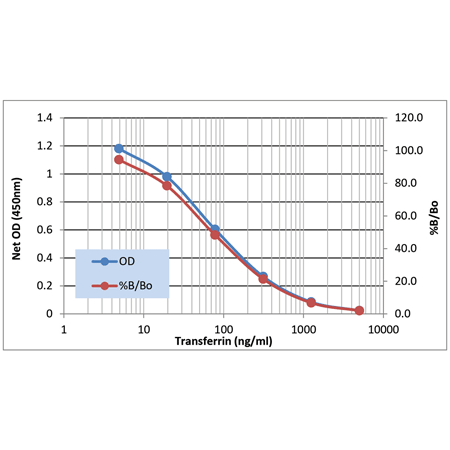-
Sensitive measurement of transferrin, detecting as little as 4.6 ng/ml
-
Negligible cross reactivity with similar proteins
-
High throughput format with results in 2 hours for up to 40 samples in duplicate
-
Fully quantitative results that surpass semi-quantitative Western blot analysis
The Transferrin ELISA kit is a colorimetric competitive immunoassay kit with results in 2 hours.
Please mouse over
Product Details
| Sensitivity: | 4.6 ng/ml (4.9 - 5000 ng/ml) |
| |
| Assay Time: | 2 hours |
| |
| Applications: | ELISA, Colorimetric detection
|
| |
| Application Notes: | For the quantitative determination of transferrin in human serum, human plasma and canine serum. |
| |
| Wavelength: | 450 nm |
| |
| Species reactivity: | Human
Dog
|
| |
| Use/Stability: | Store all components at +4°C, except standard at -20°C. |
| |
| Shipping: | Blue Ice |
| |
| Contents: | Microtiter Plate, Assay Buffer 13, Standard, Wash Buffer Concentrate, Antibody, Antibody Diluent, Tracer, Conjugate, Substrate, and Stop Solution |
| |
| Scientific Background: | Human serum transferrin, one of the members of the family of transferrin proteins, is an 80kDa glycoprotein and is a major carrier of iron in blood. Also included in this family of proteins are: i) lactoferrin, which is the iron-binding protein found in human milk and ii) ovotransferrin, which is the iron-binding protein isolated from avian egg white. Transferrin binds iron, forming a transferrin-iron complex. When this complex encounters a transferrin receptor on the surface of the cell, it binds and is transported into the cytoplasm. Once inside the cell, the iron is released and the iron- free transferrin, now referred to as “apotransferrin”, is transported back to the cell surface. Each molecule of transferrin can bind up to two atoms of iron to form reddish protein-iron complexes. Transferrin allows for the transport of the ferric iron (Fe3+) from the intestine, reticuloendothelial system and liver parenchymal cells to all cells in the body.
Measurements of serum transferrin has applications in anemia, where medical professionals may check transferrin levels in iron deficiency, as an increase in transferrin levels may be seen in patients with iron deficiency anemia. Additionally, transferrin has a role in iron overload disorders such as hemochromatosis, where transferrin levels would be decreased in plasma and serum. Decreased levels of transferrin can also be detected in patients with liver diseases, such as cirrhosis and non-alcoholic fatty liver disease. |
| |
| UniProt ID: | P02787 |
| |
| Regulatory Status: | RUO - Research Use Only |
| |
| Compatibility: | This product is compatible with the Absorbance 96 Plate Reader.
 |
| |
Product Literature References
The effect of 8-week different-intensity walking exercises on serum hepcidin, IL-6, and iron metabolism in pre-menopausal women: G. Buyukyazi, et al.; Physiol. Int.
104, 52 (2017),
Application(s): Human Serum,
Abstract;
Related Products


















